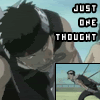What a UP Student is Not
Before I continue writing this blog, I want to greet everyone in UP a big HELLO! I just want to tell you that when I wrote this blog, I dug up all my experiences in order to make a realistic and presentable material. I dedicate this blog to my school, the University of the Philippines High School in Cebu (Char!). I promised to set all my wackiness aside, and reveal my serious side (thunder, lightning and mocking laughter). Joke, joke, joke!
The truth is, ‘What a UP student is not’ is a topic that maybe a UPian would care little about. I think the UP populace is heterogeneous. You see different characteristics, some endearing, some frustrating, and some even shocking! Contrary to popular belief, it seems to me that, there is no ‘typical’ UP student. A UP student may indeed possess many positive traits. However, there are also many negative traits that can be attributed to a UP student. Nevertheless, no matter how difficult this topic is for me, I tried to come up with a few characteristics that may differentiate a UPian (high school and college students) from a non-UPian (all levels also). I just hope you would agree with my choices.
FIRST, UPians don’t speak for their rights?
 On the contrary! A non-UPian would possibly let other people trample on their rights, but definitely not UP students. In fact, the above statement would just send people’s eyebrows up. Don’t speak for their rights? I don’t think so. As you can see, youth groups and organizations are probably found in all schools and universities. However, what differentiates UP from other schools is that, these organizations are easily mobilized into dialogues, fora or rallies. These are venues where students can openly express their sentiments, whether pro or against administration or national policies that seem oppressive to students’ welfare. Aaah, what freedom of expression! There are very few schools that tolerate these kinds of activities. What happens then is that non-UP students become apathetic and no longer care whether their rights have been violated or not. Maybe because the repression imposed by the school has led to unawareness on the part of the students of what their rights are as students. Contemplate on this my dear schoolmates. Are you apathetic? If yes, maybe you are in the wrong school.
On the contrary! A non-UPian would possibly let other people trample on their rights, but definitely not UP students. In fact, the above statement would just send people’s eyebrows up. Don’t speak for their rights? I don’t think so. As you can see, youth groups and organizations are probably found in all schools and universities. However, what differentiates UP from other schools is that, these organizations are easily mobilized into dialogues, fora or rallies. These are venues where students can openly express their sentiments, whether pro or against administration or national policies that seem oppressive to students’ welfare. Aaah, what freedom of expression! There are very few schools that tolerate these kinds of activities. What happens then is that non-UP students become apathetic and no longer care whether their rights have been violated or not. Maybe because the repression imposed by the school has led to unawareness on the part of the students of what their rights are as students. Contemplate on this my dear schoolmates. Are you apathetic? If yes, maybe you are in the wrong school.

SECOND, UPians don’t try their best to achieve their goals?
Now that’s funny. How can anybody think that? A non-UP student may easily give up their dreams and goals especially when achieving these becomes difficult. For a UP student, passing the UPHSAT or UPCAT is a goal in itself. Many dreamed of entering the premier state university of the Philippines but only a few can be accommodated. Passing the UP entrance exams never stops a UP student from dreaming on or achieving higher goals.
A non-UPian may be contented with a passing grade or “so-so” performance in school. He or she may shrug off a few failing marks thinking, “there’s always next year or next semester”. Why sacrifice my social life or sleep by studying or by “burning the midnight candle?” It doesn’t matter to them if they have low or failing grades, anyway “my parents can afford to pay the tuition”. UPians on the other hand, have to make many sacrifices to achieve their goals. Break time is sometimes sacrificed. For example, when there is an upcoming test, the room is soooo silent. Why? Of course, all are studying (or so it seemed to me). They have to study and study hard to pass the exams. A failing mark wouldn’t look good especially if your future plan is to take the UPCAT or graduate with honors.
A non-UPian may be contented with a high school diploma. “My parents do not have the financial capacity to send me to college. I’ll just look for work in the department store or production line or better yet, I’ll apply abroad as a domestic helper.” Well, these are still goals in themselves but if you are a UP student, will you be contented with these goals? If your answer is yes, you may transfer to another school where you don’t have to make a lot of sacrifices.
Before I continue writing this blog, I want to greet everyone in UP a big HELLO! I just want to tell you that when I wrote this blog, I dug up all my experiences in order to make a realistic and presentable material. I dedicate this blog to my school, the University of the Philippines High School in Cebu (Char!). I promised to set all my wackiness aside, and reveal my serious side (thunder, lightning and mocking laughter). Joke, joke, joke!
The truth is, ‘What a UP student is not’ is a topic that maybe a UPian would care little about. I think the UP populace is heterogeneous. You see different characteristics, some endearing, some frustrating, and some even shocking! Contrary to popular belief, it seems to me that, there is no ‘typical’ UP student. A UP student may indeed possess many positive traits. However, there are also many negative traits that can be attributed to a UP student. Nevertheless, no matter how difficult this topic is for me, I tried to come up with a few characteristics that may differentiate a UPian (high school and college students) from a non-UPian (all levels also). I just hope you would agree with my choices.
FIRST, UPians don’t speak for their rights?
 On the contrary! A non-UPian would possibly let other people trample on their rights, but definitely not UP students. In fact, the above statement would just send people’s eyebrows up. Don’t speak for their rights? I don’t think so. As you can see, youth groups and organizations are probably found in all schools and universities. However, what differentiates UP from other schools is that, these organizations are easily mobilized into dialogues, fora or rallies. These are venues where students can openly express their sentiments, whether pro or against administration or national policies that seem oppressive to students’ welfare. Aaah, what freedom of expression! There are very few schools that tolerate these kinds of activities. What happens then is that non-UP students become apathetic and no longer care whether their rights have been violated or not. Maybe because the repression imposed by the school has led to unawareness on the part of the students of what their rights are as students. Contemplate on this my dear schoolmates. Are you apathetic? If yes, maybe you are in the wrong school.
On the contrary! A non-UPian would possibly let other people trample on their rights, but definitely not UP students. In fact, the above statement would just send people’s eyebrows up. Don’t speak for their rights? I don’t think so. As you can see, youth groups and organizations are probably found in all schools and universities. However, what differentiates UP from other schools is that, these organizations are easily mobilized into dialogues, fora or rallies. These are venues where students can openly express their sentiments, whether pro or against administration or national policies that seem oppressive to students’ welfare. Aaah, what freedom of expression! There are very few schools that tolerate these kinds of activities. What happens then is that non-UP students become apathetic and no longer care whether their rights have been violated or not. Maybe because the repression imposed by the school has led to unawareness on the part of the students of what their rights are as students. Contemplate on this my dear schoolmates. Are you apathetic? If yes, maybe you are in the wrong school.
SECOND, UPians don’t try their best to achieve their goals?
Now that’s funny. How can anybody think that? A non-UP student may easily give up their dreams and goals especially when achieving these becomes difficult. For a UP student, passing the UPHSAT or UPCAT is a goal in itself. Many dreamed of entering the premier state university of the Philippines but only a few can be accommodated. Passing the UP entrance exams never stops a UP student from dreaming on or achieving higher goals.
A non-UPian may be contented with a passing grade or “so-so” performance in school. He or she may shrug off a few failing marks thinking, “there’s always next year or next semester”. Why sacrifice my social life or sleep by studying or by “burning the midnight candle?” It doesn’t matter to them if they have low or failing grades, anyway “my parents can afford to pay the tuition”. UPians on the other hand, have to make many sacrifices to achieve their goals. Break time is sometimes sacrificed. For example, when there is an upcoming test, the room is soooo silent. Why? Of course, all are studying (or so it seemed to me). They have to study and study hard to pass the exams. A failing mark wouldn’t look good especially if your future plan is to take the UPCAT or graduate with honors.
A non-UPian may be contented with a high school diploma. “My parents do not have the financial capacity to send me to college. I’ll just look for work in the department store or production line or better yet, I’ll apply abroad as a domestic helper.” Well, these are still goals in themselves but if you are a UP student, will you be contented with these goals? If your answer is yes, you may transfer to another school where you don’t have to make a lot of sacrifices.


































